Earth Day 2018, Pittsburgh and environs
Part One
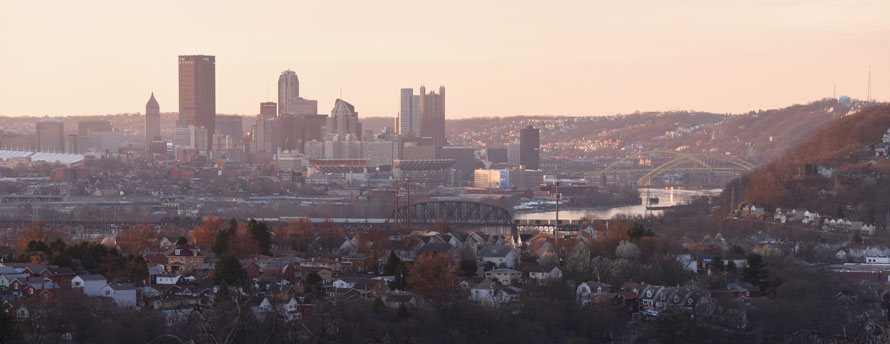
In April 2018, my friend George Hiotis and I made a fourteen-day, 2,300-mile journey from my home in Bloomsburg, Pennsylvania, to Chicago and back. We had a GREAT time.
Ostensibly, we made the trip for the Center for Railroad Photography & Art conference, but we spent most of a week before and all of a week afterwards on the road. I came back with 4,200 pictures—crazy, right?—and George brought home more than 5,000. We photographed at something like seventy-five locations, in Pennsylvania, Ohio, Indiana, Illinois, and West Virginia, from before dawn until long after dark on most days. We stumbled on some astonishing places and buildings in addition to the dozens that George had put on the initial itinerary, developed through scads of research in the months before the trip. We also met some memorable people, a few of whom I photographed. I had set out on this trip determined to overcome my self-consciousness about photographing strangers, and you will see some of the results here.
George, who lives in New Jersey, and I had made similar trips to the CRP&A conference in 2016 and 2017, but this year for the first time he presented at the conference. George has just started to get his due as one of the great American railroad photographers. For the conference, George put together a narrated slide show of his work documenting what he calls “The Last Outposts,” the manned interlocking towers primarily on the former Baltimore & Ohio main line along the Potomac and crossing the Alleghenies in Maryland, West Virginia, and Pennsylvania. Before these examples of 19th- and 20th-century technology disappeared, George made twenty-one trips totaling eighty-six days in the 1990s and early 2000s to Hancock and Miller and SA and the others, getting to know the operators and getting access to their sanctums. Three days before presenting at CRP&A, George did a practice run of the show at the monthly meeting of the 20th Century Railroad Club in Chicago, in the Founder’s Room at Union Station, just off the main waiting room (after Grand Central’s concourse in New York, one of the grandest railroad spaces in America). George also projected his legendary multi-media show “Suburban Symphony” and a selection of his other images, including of the Rio Grande Zephyr, steam in South Africa, and GG1s on the Northeast Corridor. You can see a tiny slice of George’s lifetime’s work at his website, George Hiotis Photography.
For our last two days on the road, we concentrated on Pittsburgh—a city where we could easily photograph for weeks and months. We had spent a day there at the tail end of each of the previous CRP&A odysseys, and we wanted to go back to some of the places we had visited before and also some new ones (and of course we stumbled on yet more as well). The story of our last morning actually started two years earlier, when we went high up into the Sheraden neighborhood, west of the Ohio River, looking for a view down to the Ohio Connecting Bridge. The Pennsylvania Railroad built the double-track, many-many-many-span river crossing in 1915 (actually constructed around the 1890 single-track bridge while it remained in service). It passes over Brunot Island in the middle of the river, with a 406-foot through-truss span over the western channel, a 508-foot through-truss span over the eastern channel, and shorter deck trusses the rest of its 1.3-mile length, including approaches.
On an April evening in 2016, we had photographed the bridge from track level at its western end after clambering up a steep hillside and doing some bushwhacking. Looking up from there, we could see houses on the ridge, and a glance at the street map revealed that from some backyard or other we should have a panoramic view of the bridge. The next morning, bright and early, we took George’s Subaru straight up the side of a mountain, or so it felt, and came out at the top of a street which sloped down to the north like a ski jump. After parking the car—with the wheels turned as hard as possible to the curb, and hoping that the electric parking brake would hold—we walked up and down the sidewalk (complete with flights of stairs, on account of the slope), peering between the houses, trying to decide which door we should knock on. A man driving a van stopped and addressed us—as one would expect a neighborhood resident to do—asking what we needed. George explained, and the man said “I own these three houses; come have a look in the backyard.” Eureka!
We did not even have to get out of the car to realize we had hit another jackpot.
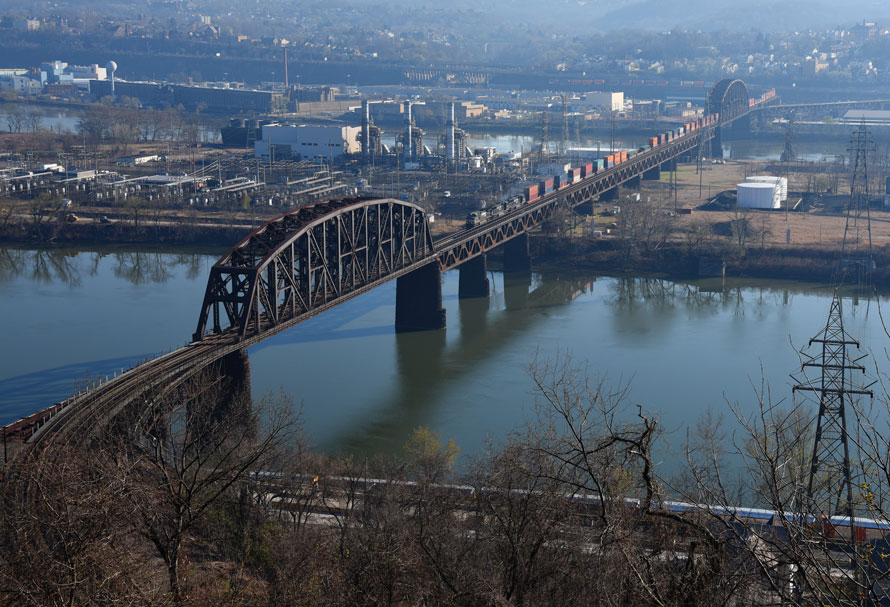
Last year, we returned to the same backyard, and I brought a large print of the photo above for Ron, the owner. This year, we went back yet again, and Ron again graciously welcomed us, standing and talking with us on the Saturday morning for a couple of hours while we waited for trains. Without the aggressive tree and brush cutting that Ron has done where his backyard drops off the edge, we would have no view at all here, and we appreciate his industriousness.
While we talked, Ron pointed to the north, downriver (to the left in the photo), to another prominence. “You should go up to that new development; you’ll get a good view from there too.” So later that day under a solid overcast, after a stop at St. Mary’s Cemetery in McKees Rocks from which we got a decent view, and where we ate our peanut butter and jelly sandwiches for lunch, we made our way to where Ron had pointed. The houses did indeed look new, and more or less pleasant on Pleasant Ridge Road, but they were already starting to fade, and the people sitting on the porches did not look especially friendly. At the south edge of the development, something approximating a park lay on the other side of a fence with a locked gate, but the trees beyond it obscured the view to the O.C. Bridge and downtown Pittsburgh beyond. We started back down the hill, but I suggested we look at the streets on the other side of the main road; you never know, right?
In a much older neighborhood, with some faux-Tudor houses that looked like they dated from the 1930s, we went up a dead-end street. Its far end would have the view—except for the trees. So we tried the next street. A permanent wooden barricade marked its end, with a patch of mowed grass beyond that, and then some low brush but no trees. We did not even have to get out of the car to realize we had hit another jackpot. The view encompassed a vast area, from Brighton Heights on the far side of the river, on our left, to the hills by Greentree to the right, the whole borough of McKees Rocks on the flats below in the foreground, downtown Pittsburgh straight ahead in the background, and the O.C. Bridge in the middle, its western end silhouetted against a short stretch of the Ohio. More than five miles separated us from the tallest buildings downtown.
“We’ll get an even better view from up on that porch,” I said to George, and I walked up the driveway of the last house on the west side of the street, approaching a young woman standing next to a car. I explained our quest; she smiled and said that the house did not belong to her but to her in-laws and I should go up and knock on the porch door. So I did. A dog inside commenced barking and did not stop when another young woman came to the door. She stepped out onto the porch and I explained again. “It’s my father’s house,” she said, “and he won’t mind. You can talk to him there,” pointing to the front yard, where an older man had now appeared, puttering about a masonry wall a-building. George called to the old man from the sidewalk, and he allowed that we could come use the porch the next morning, anytime after 8:00. We thanked him cordially and drove away, happy to have our next morning’s location sewn up. (Under the clouds, photos right then would not have amounted to much.)
On Sunday morning in the pre-dawn, the indigo sky still showed a few stars and not a single cloud. As we drove up through McKees Rocks though, the view to the west revealed a solid front headed our way, and by the time we parked on the dead-end street a few minutes before 6:00 we seemed to have only a few minutes remaining before the whole sky went dark again.
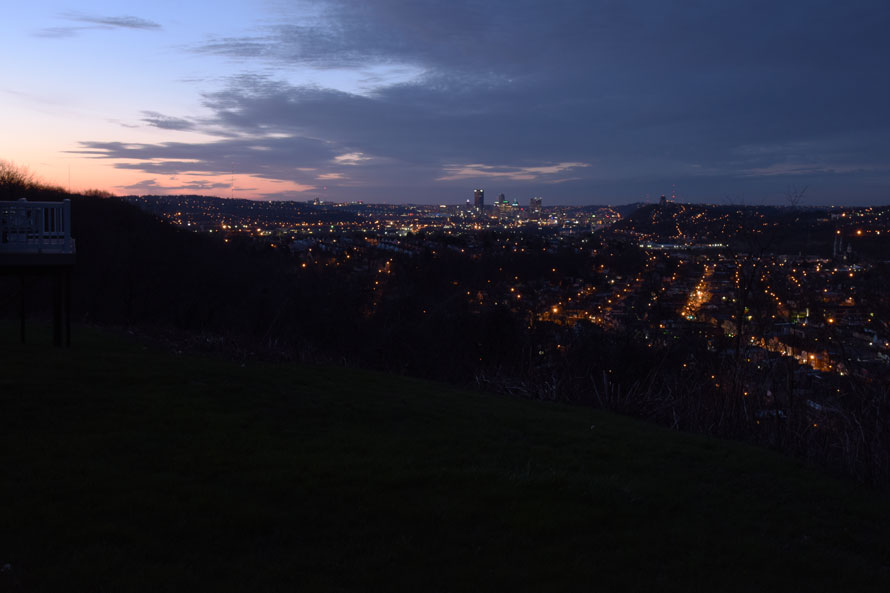
Respecting the hour, we did not go up on the porch and wake the dog (and by extension the rest of the household), so we set up our tripods on the patch of grass; not such a bad view from there either. The clouds made us somewhat unhappy, even as they turned pink with the light of the rising sun touching their undersides, but overall we felt quite calm and content. A few birds sang, and we even saw a deer walk across the street. I did manage to set off the car alarm in the Subaru by hitting the panic button instead of the unlock button when I went to get something out of my camera bag, but no lights came on in the nearby houses, and I did not hear any dogs start to bark.
Some time passed before the trains started to run. I first saw a westbound headlight at twenty minutes before 7:00. Two Norfolk Southern diesels, a GE and an EMD running elephant-style, led the mixed freight onto the O.C. Bridge, more than two miles away.
When she came back, she brought a tray with a French-press coffee pot and china cups
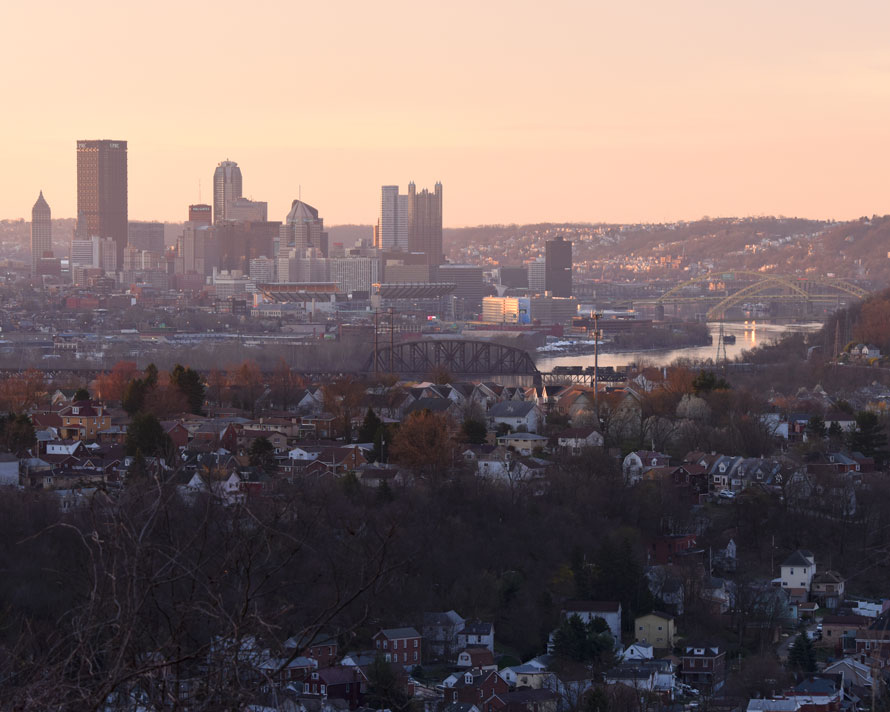
In the next two hours we saw another half-dozen trains, eastbounds as well as westbounds. But best of all we got to change our vantage point to one just slightly better – and not on the porch I’d scoped out the day before. Around 7 a.m. a woman came out of the house across the street from that one, saw us standing in the grass, and came over. We explained our goals and methods, and she said “You should see the view from my deck.”
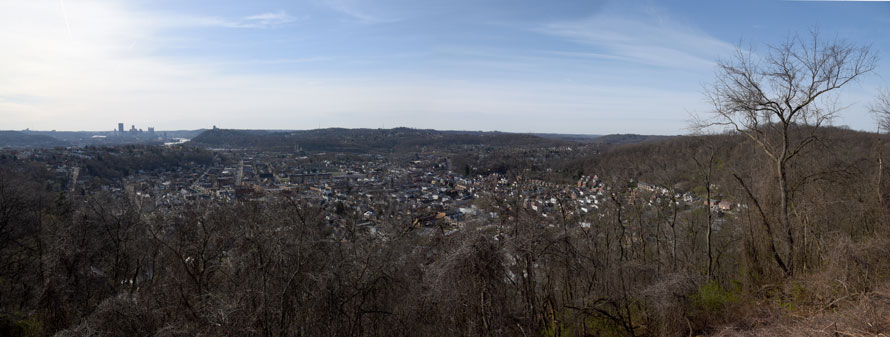
Our host has lived here for many years and plainly appreciated that view. We felt quite grateful that she chose to share it with us. We talked for a while, about our origins and careers, and then she went inside. When she came back, she brought a tray with a French-press coffee pot and china cups, as well as cream and sugar, and George and I felt like utter ingrates and cads when we had to tell her that we don’t drink the stuff. But I did get her to pose for a picture, with that view behind her. (Respecting her wish for privacy, I cannot share the photo here, but I hope you will take my word for it that it captures her generous spirit. A friend who did see it said this: “She looks like somebody who would be fun to talk with. The warm colors in her face and her red shirt contrast nicely with the blues of the out-of-focus cityscape behind her.”)
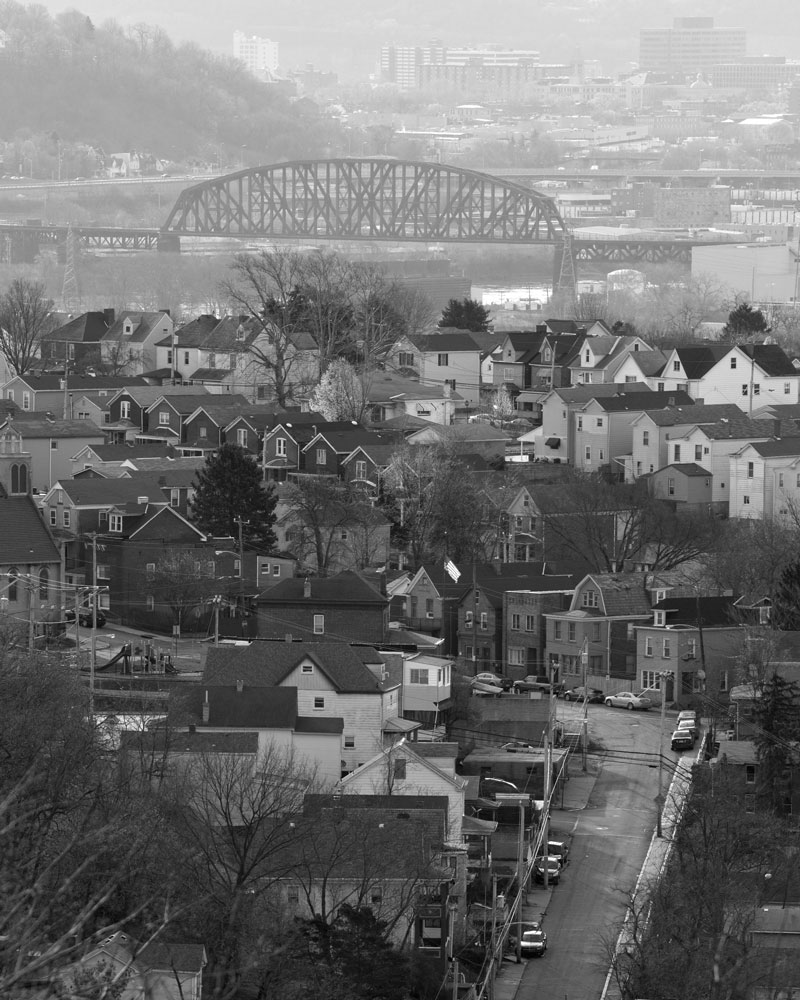
As the sun got higher, the clouds thinned, but the air got soupier, and by 9:00 our long lenses had done about all they could for us. We would very much like to come back here, at other times of year and with the sun at other angles, because this prospect has such promise; even without a train, the view across McKees Rocks’ rows of tightly-packed houses fascinates. The American flag waving in the middle of that picture caught the sunlight beautifully, although the scene overall works better in black & white.
We watched one last train go west . . .

. . . and then bid our host adieu, her e-mail address in my notebook so I could send her copies of the pictures. Driving away, we saw a small girl sitting on a front walk’s steps, watching a radio-controlled toy car zipping around in the street near the curb. I did not see anyone with the controller, and I drove carefully to make sure I would not squash the model.
We crossed the Ohio on the McKees Rocks Bridge and the Allegheny on I-279, passed the Point and the Strip District, and then made our way up into Polish Hill, a neighborhood east of downtown. We had visited it the previous day too, but in poor light, and we wanted to try again to photograph an ancient “ghost sign” that George had found in his research on the ’net. We had looked at a few other signs like this earlier on the trip, including one for a Packard dealership in Cleveland (Packard stopped making cars in 1956), but none so large. This one, for Mother’s Bread, covers the entire side of a triple-decker apartment house.
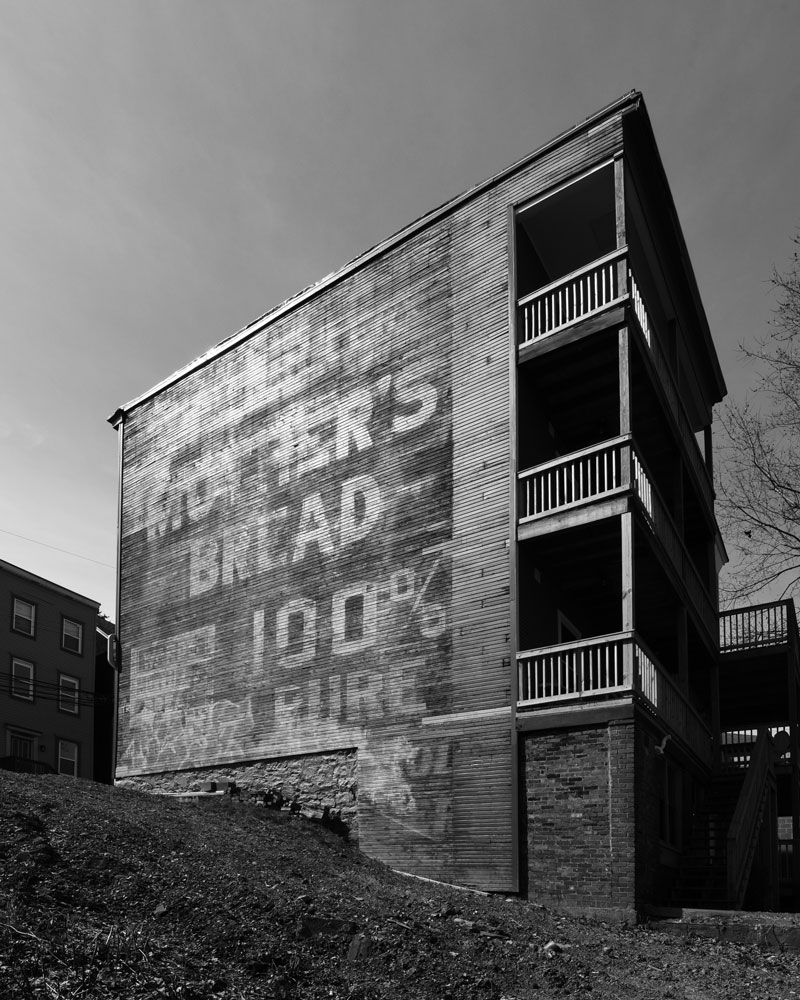
According to a local TV news story from 2014, a building had stood next to it until a fire in 2008, and I wonder: When did the sign originally get painted, and for how long would anyone have seen it before that next building went up?

Polish Hill has plainly become a hip place to live: On the corner of Hancock Street (far left in the photo above, looking up Dobson Street), a little coffee shop has gone in, and on the tiny patio outside, the two tables for two had heavily-tattooed young people sitting at them; a “Black Lives Matter” sign hung in the window, and right next door, a single doorway served Cruel Noise Records and the Copacetic Comics Company.
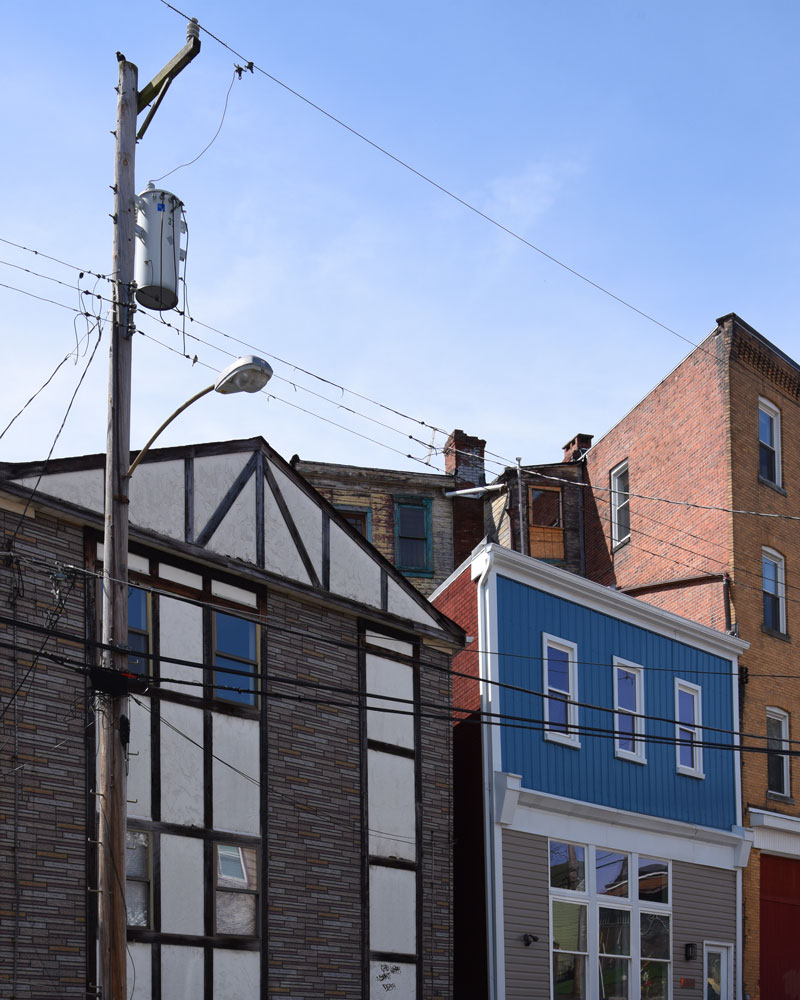
We had seen almost no one on the sidewalks while we photographed the sign, just one old man shuffling up the hill; perhaps he had gone to Mass? The enormous yellow-brick church with its copper domes drew us, although we kept our eyes open on the way: lots to see here.
Down the block, I passed a door, ajar, that had two orange cats sitting just within, watching the world go by, and also from within came the smells of a homemade brunch—bacon and, perhaps, biscuits.
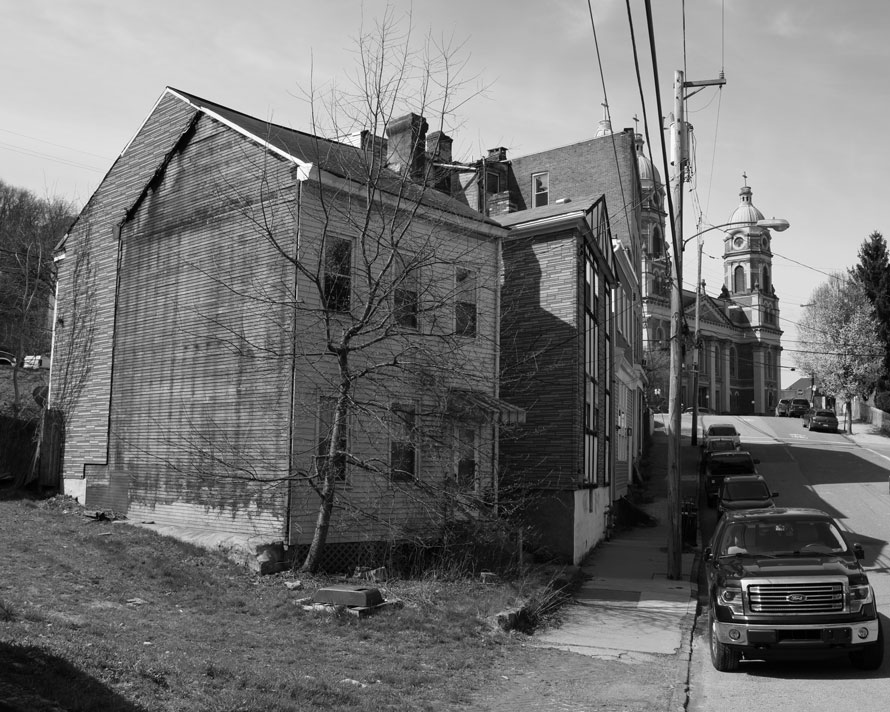
And the church from up close certainly did not disappoint:
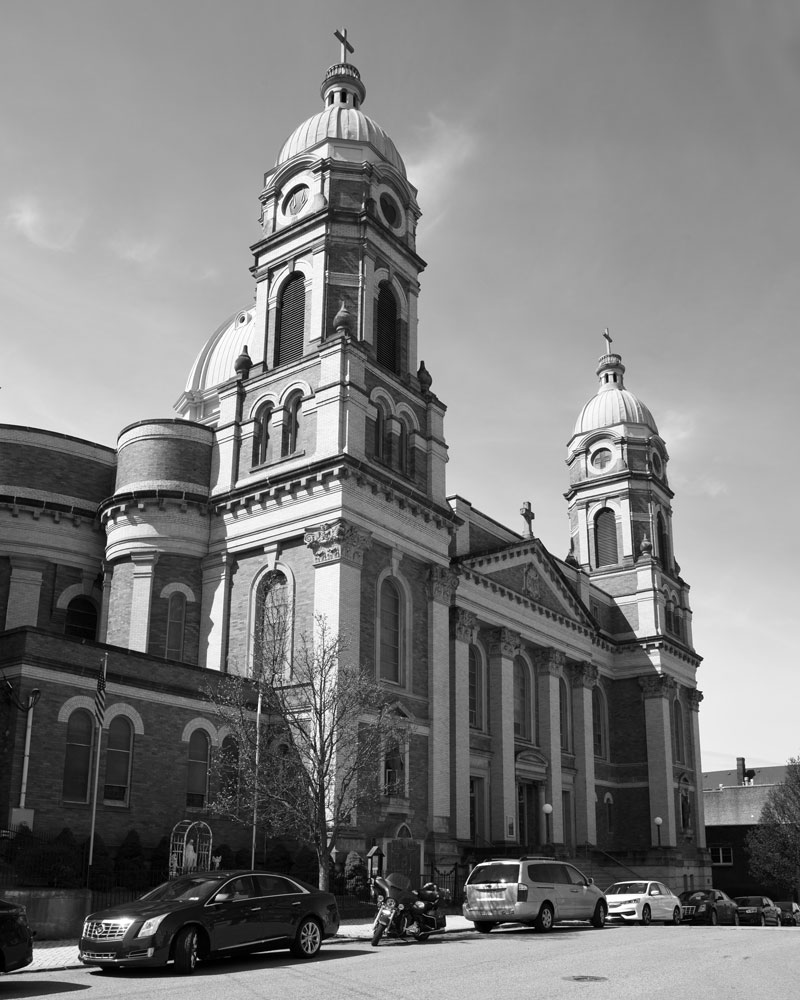
We arrived at the Immaculate Heart of Mary Roman Catholic church just as the English-language mass started. Two hours earlier, we could have heard one in Polish. I don’t know how many people still come for Mass in Polish, but we sure did not find an overabundance at the English one. To keep out of the way, we climbed up into the balcony at the back of the sanctuary, and from there we could count the parishioners by the few dozen:
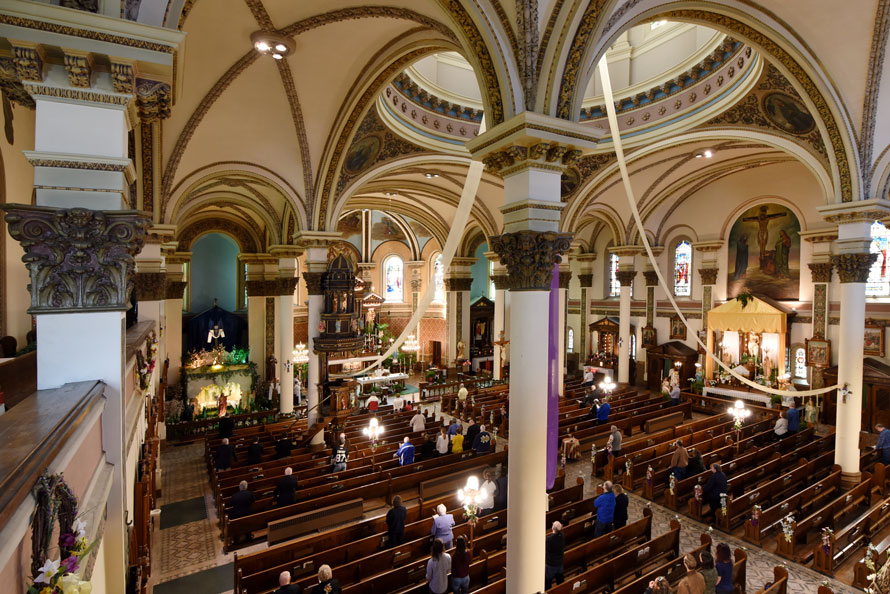
Quite a spectacular space, with the light pouring in from the dome above:
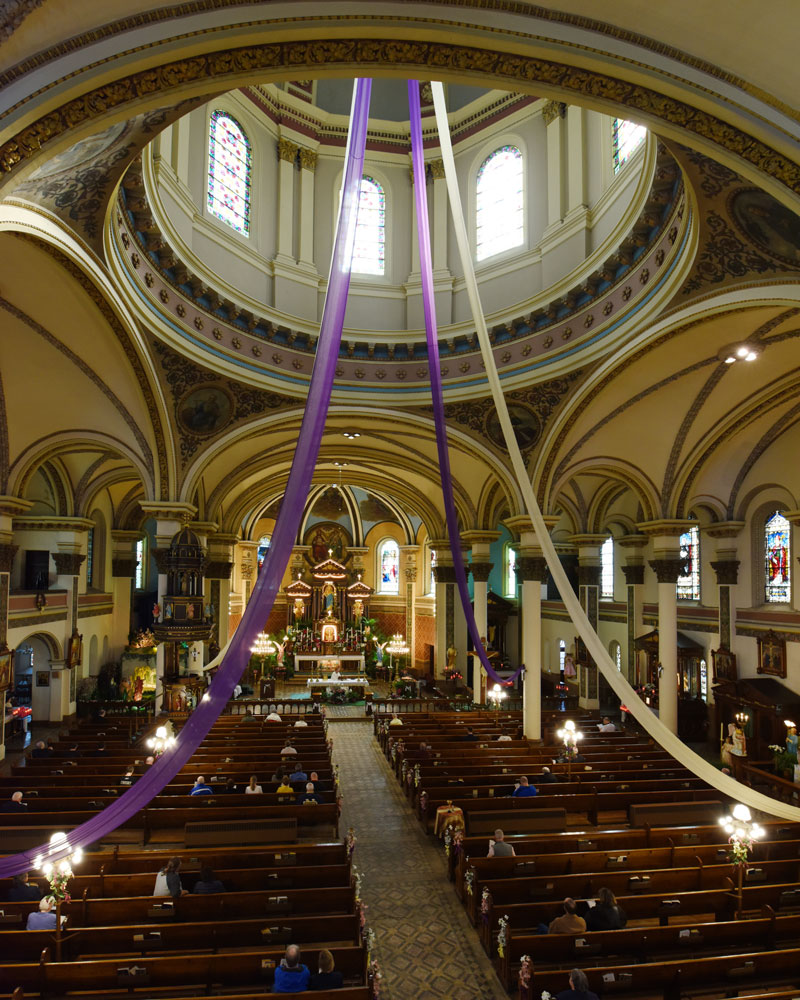
The organist sat with his back to the balcony railing, facing the choir—a quartet of people in their sixties and seventies, I would guess.
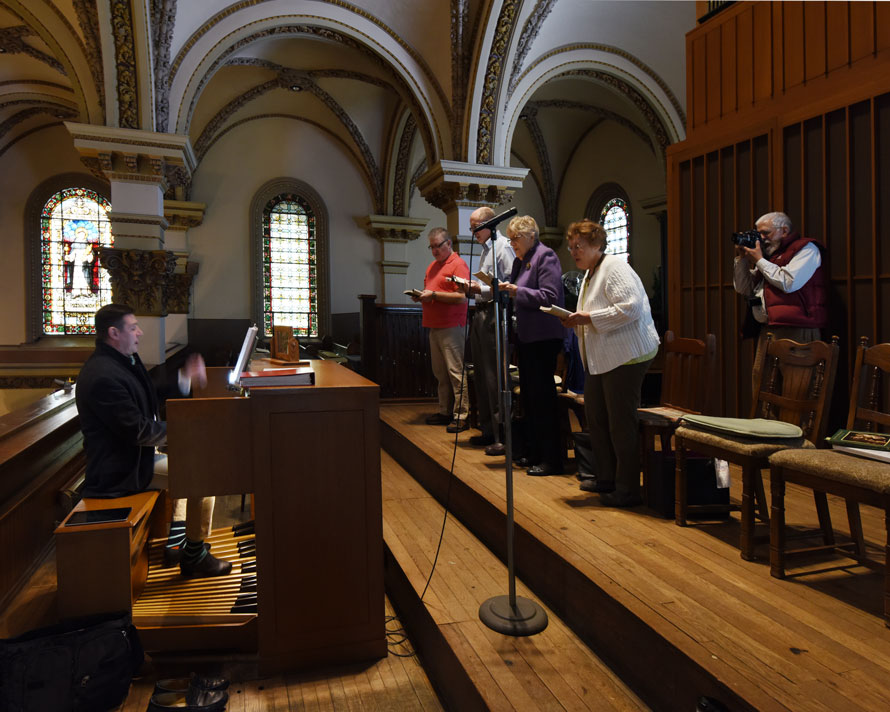
Although I felt quite self-conscious intruding on their worship, George had no such compunction, and he quickly gravitated to the organist, photographing him from right up close with that awesome view behind him. Far from put out, at the first opportunity the organist asked to look at the pictures George had made (ah, the advantages of a digital camera), and he liked what he saw: He gave George his business card and asked to have copies sent his way. Before going back to work (he led some of the singing as well as playing the organ), the man at the keyboard also gave us a brief history of the church and its designer, a very prolific architect named William Ginther. The organ, by the way, dates from 1970, a replacement for the original (the building opened in 1906), and although the pictures don’t show it, the balcony has become a storage space for the church, with most of the pews filled with large cardboard boxes, interspersed with wreaths and fake Christmas trees. Even the stairways leading up here had gotten half-filled with boxes.
Before coming inside the church, I had not paid attention to the remaining memory-card capacity in my camera, and I ran out up in the balcony. I told George I needed to go back to the car and left him there, still happily engaged. As soon as I stepped outside, I regretted again having run out of memory, because I could not photograph the people coming towards me on the sidewalk, two hipster men in shorts and t-shirts, almost every inch of exposed skin tattooed. One had a baby in a Snugli on his chest, while the other pushed a toddler in a stroller. Down the block, I passed a door, ajar, that had two orange cats sitting just within, watching the world go by, and also from within came the smells of a homemade brunch—bacon and, perhaps, biscuits.
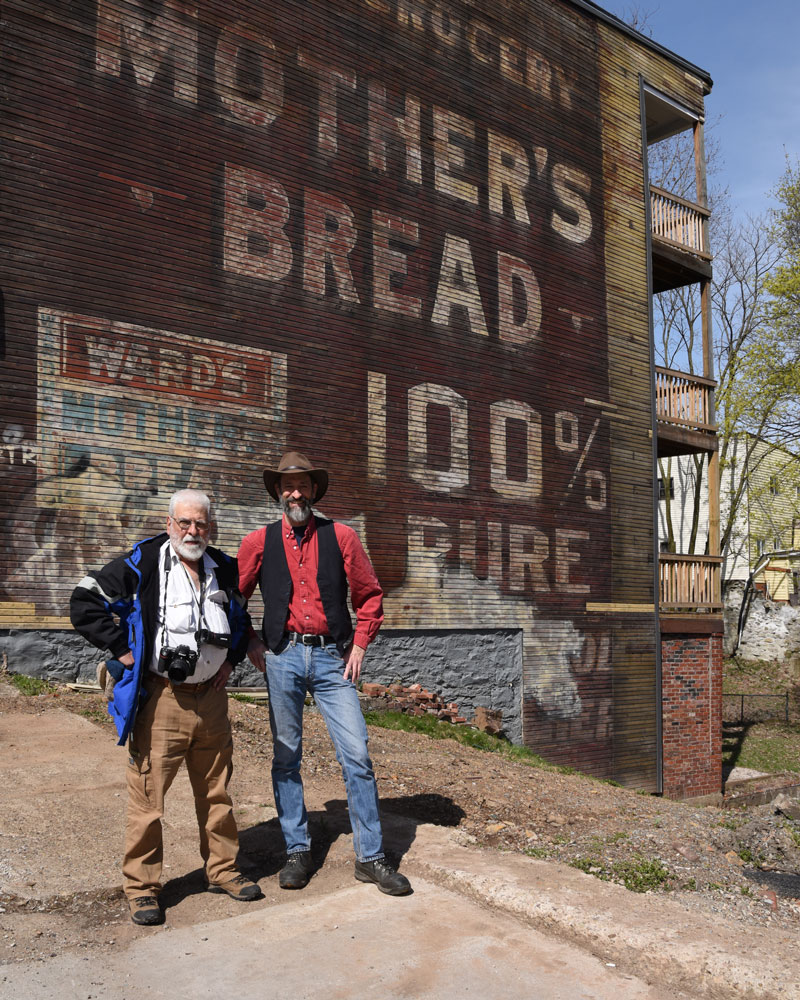
As I got to the car, George phoned me. He had done what he could in the church and would come to meet me. (He really wanted to set his camera on the floor directly under the dome, using the hyperwide lens, but he figured that during Mass this might come across as rude.) Before getting back in the car, we made a photo of ourselves in front of the ghost sign—the “official portrait” of the two photographers on this trip, George on the left, me on the right.
Oren Helbok – Photographs and text Copyright 2018
Join us next week, for Part Two of "Sunday in the Car with George"
Great story. Most impressive photos for me were the old sign on the apartment block.
I find it interesting, Jim, that others share that same opinion about the Mother’s Bread sign — not at all what I would think of as the highlight of the day (but on the other hand you have not read part 2 yet!). Very glad you have enjoyed the trip so far —
Wonderful – wow – thanks for the words and the photos – a super 20 minutes
Very gratifying that you have enjoyed the words and photos so far, Tom, and I encourage you to visit the “Stories” page of my Web site (wheresteamlives.net/stories) for other tales from on the road.
Oren continues to be an inspiration of mine; this is the latest example. Reading this makes me want to hit the road, not so much with a rigid agenda – but to explore and discover along the way. I always say that it’s not the destination but rather the journey. The people met and the stories they share. He subscribes to the very same philosophy.
I have known Oren for years now without a beard, after seeing the photo of him and George it has become apparent the reason of his newly grown facial hair.
As always a great story Oren! Not only do you have the ability to capture with photos, but also the talented gift to put it to words which holds the reader captivated.
Matthew
Definitely leave the rigid agenda at home, Matthew. Thanks for your comments here. As for the beard, it came and went too — no rigid agenda there either!
Wonderful photos and just as great writing. Enjoyable. While I like “modern” railroading, I wish you guys were around in the golden years of railroads….the 1950’s. Think of the wonderful shots you’d make of NYC, WM, Penn, PWV, OW, BO, CO, NW, and all the rail lines into Chicago….ATSF, , CGW, CEI, Monon, CBQ, GTW, etc. Thanks again for sharing!
Man, do I ever wish I could have seen the golden years too, Don! But I grew up on the photos of Hastings and Shaughnessy and Plowden and Steinheimer and Beebe and Clegg and Hale and and and and and — all of the masters whose work inspired me; I will confess to feeling plenty of nostalgia for the era I missed, but, as you can see from the story here, I try to make the best of what we’ve still got (even if this hardly EVER means a three-quarter shot of a widecab diesel). Happy to get to share what I do with people like you who appreciate it.
So special Oren.
We lived for 8 years 15 mi south of Conway in Beaver County next to WV and Ohio.
I was transferred along with my wife who also worked for CR.
Started out as Mgr Misc Billing for NE Region of CR with 6 people reporting to me.
Later when Greentree was cab signaling Ft Wayne and Cleveland Lines they transferred me as Movement Director for that district PRR Lines West until sufficient trainees could assume the territory.
I then resumed Mgr of Misc billing NE Dvn due to my RR accounting background until NS beckoned in 1999.
Transferred to Atlanta as Dvn Supt GA dvn.
I was tasked to integrate new Intermodal Term 8 miles west from a 100 year old facility in NW Atlanta that contained an old loco servicing facility 4 miles away.
Yard was Inman ex Sou new yard was at Austell Whittaker Intermodal and loco shop was Peagram that dated from early Sou steam.
Retirement after leading intigraution unit was about 6 years later in 2005 after 44 years duration with 8 railroads.
Truly
Gary Olden
You left out Reading Co with the other noble roads.